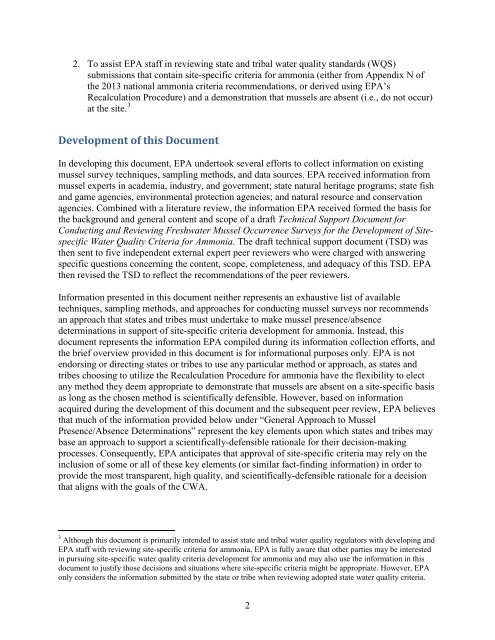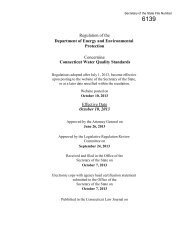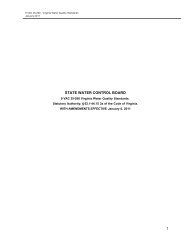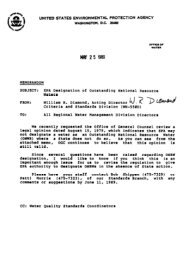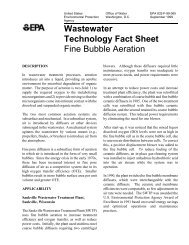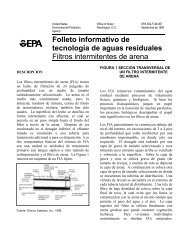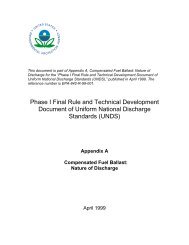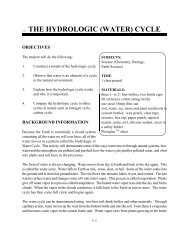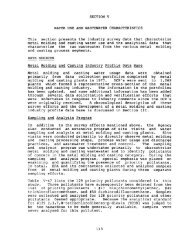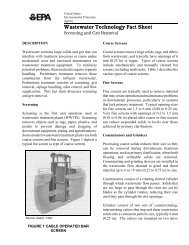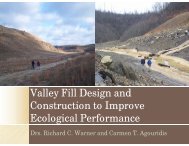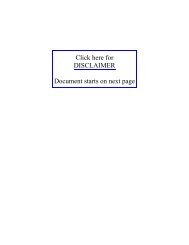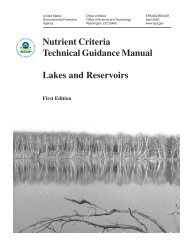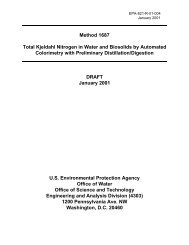Technical Support Document for Conducting and Reviewing ... - Water
Technical Support Document for Conducting and Reviewing ... - Water
Technical Support Document for Conducting and Reviewing ... - Water
You also want an ePaper? Increase the reach of your titles
YUMPU automatically turns print PDFs into web optimized ePapers that Google loves.
2. To assist EPA staff in reviewing state <strong>and</strong> tribal water quality st<strong>and</strong>ards (WQS)<br />
submissions that contain site-specific criteria <strong>for</strong> ammonia (either from Appendix N of<br />
the 2013 national ammonia criteria recommendations, or derived using EPA’s<br />
Recalculation Procedure) <strong>and</strong> a demonstration that mussels are absent (i.e., do not occur)<br />
at the site. 3<br />
Development of this <strong>Document</strong><br />
In developing this document, EPA undertook several ef<strong>for</strong>ts to collect in<strong>for</strong>mation on existing<br />
mussel survey techniques, sampling methods, <strong>and</strong> data sources. EPA received in<strong>for</strong>mation from<br />
mussel experts in academia, industry, <strong>and</strong> government; state natural heritage programs; state fish<br />
<strong>and</strong> game agencies, environmental protection agencies; <strong>and</strong> natural resource <strong>and</strong> conservation<br />
agencies. Combined with a literature review, the in<strong>for</strong>mation EPA received <strong>for</strong>med the basis <strong>for</strong><br />
the background <strong>and</strong> general content <strong>and</strong> scope of a draft <strong>Technical</strong> <strong>Support</strong> <strong>Document</strong> <strong>for</strong><br />
<strong>Conducting</strong> <strong>and</strong> <strong>Reviewing</strong> Freshwater Mussel Occurrence Surveys <strong>for</strong> the Development of Sitespecific<br />
<strong>Water</strong> Quality Criteria <strong>for</strong> Ammonia. The draft technical support document (TSD) was<br />
then sent to five independent external expert peer reviewers who were charged with answering<br />
specific questions concerning the content, scope, completeness, <strong>and</strong> adequacy of this TSD. EPA<br />
then revised the TSD to reflect the recommendations of the peer reviewers.<br />
In<strong>for</strong>mation presented in this document neither represents an exhaustive list of available<br />
techniques, sampling methods, <strong>and</strong> approaches <strong>for</strong> conducting mussel surveys nor recommends<br />
an approach that states <strong>and</strong> tribes must undertake to make mussel presence/absence<br />
determinations in support of site-specific criteria development <strong>for</strong> ammonia. Instead, this<br />
document represents the in<strong>for</strong>mation EPA compiled during its in<strong>for</strong>mation collection ef<strong>for</strong>ts, <strong>and</strong><br />
the brief overview provided in this document is <strong>for</strong> in<strong>for</strong>mational purposes only. EPA is not<br />
endorsing or directing states or tribes to use any particular method or approach, as states <strong>and</strong><br />
tribes choosing to utilize the Recalculation Procedure <strong>for</strong> ammonia have the flexibility to elect<br />
any method they deem appropriate to demonstrate that mussels are absent on a site-specific basis<br />
as long as the chosen method is scientifically defensible. However, based on in<strong>for</strong>mation<br />
acquired during the development of this document <strong>and</strong> the subsequent peer review, EPA believes<br />
that much of the in<strong>for</strong>mation provided below under “General Approach to Mussel<br />
Presence/Absence Determinations” represent the key elements upon which states <strong>and</strong> tribes may<br />
base an approach to support a scientifically-defensible rationale <strong>for</strong> their decision-making<br />
processes. Consequently, EPA anticipates that approval of site-specific criteria may rely on the<br />
inclusion of some or all of these key elements (or similar fact-finding in<strong>for</strong>mation) in order to<br />
provide the most transparent, high quality, <strong>and</strong> scientifically-defensible rationale <strong>for</strong> a decision<br />
that aligns with the goals of the CWA.<br />
3 Although this document is primarily intended to assist state <strong>and</strong> tribal water quality regulators with developing <strong>and</strong><br />
EPA staff with reviewing site-specific criteria <strong>for</strong> ammonia, EPA is fully aware that other parties may be interested<br />
in pursuing site-specific water quality criteria development <strong>for</strong> ammonia <strong>and</strong> may also use the in<strong>for</strong>mation in this<br />
document to justify those decisions <strong>and</strong> situations where site-specific criteria might be appropriate. However, EPA<br />
only considers the in<strong>for</strong>mation submitted by the state or tribe when reviewing adopted state water quality criteria.<br />
2


